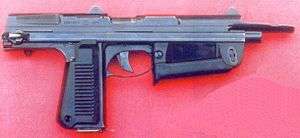FB PM-63
The PM-63 RAK (often incorrectly referred to as Ręczny Automat Komandosów—"commandos' hand-held automatic"; the name itself means cancer or crayfish in Polish) is a Polish 9×18mm submachine gun, designed by Piotr Wilniewczyc in cooperation with Tadeusz Bednarski, Grzegorz Czubak and Marian Wakalski.[1] The RAK combines the characteristics of a self-loading pistol and a fully automatic submachine gun.[2]
| PM-63 RAK | |
|---|---|
 The RAK submachine gun with stock and foregrip collapsed | |
| Type | Submachine gun, Personal defense weapon |
| Place of origin | Poland |
| Service history | |
| In service | 1965–present |
| Used by | See Users |
| Wars | Warsaw Pact invasion of Czechoslovakia Vietnam War Yom Kippur War Sino-Vietnamese wars Israeli-Arab wars Iran–Iraq War Gulf War Provisional Irish Republican Army campaign Iraq War War in Donbass |
| Production history | |
| Designer | Piotr Wilniewczyc |
| Designed | 1950s |
| Manufacturer | FB Radom |
| Produced | 1967–1977 |
| No. built | Approx. 80,000 |
| Variants | PM-70, PM-73, Type 82 |
| Specifications | |
| Mass | 1.6 kg (3.53 lb) |
| Length | 583 mm (23.0 in) stock extended / 333 mm (13.1 in) stock collapsed |
| Barrel length | 152 mm (6.0 in) |
| Height | 145 mm (5.7 in) (short magazine) 213 mm (8.4 in) (long magazine) |
| Cartridge | 9×18mm Makarov (PM-63, Type 82) 9×19mm Parabellum (PM-70) .380 ACP (9×17mm Short) (PM-73) 7.62×25mm Tokarev (Type 82) |
| Action | Straight blowback |
| Rate of fire | 650 rounds/min |
| Muzzle velocity | 320 m/s (1,050 ft/s) |
| Effective firing range | 75 and 150 m sight adjustment (9×19mm Parabellum) |
| Feed system | 15 or 25-round box magazine |
| Sights | Flip rear sight, front blade 153 mm (6.0 in) sight radius |
History
Development of the RAK dates back to the late 1950s when the concept was first proposed at the Warsaw University of Technology in response to a requirement for a light hand-held defensive weapon for rear-echelon soldiers such as gun crews and vehicle drivers. After the death of the chief designer Piotr Wilniewczyc in 1960, the submachine gun’s development was eventually resumed and completed by the state-operated Łucznik Arms Factory in the city of Radom, where it was produced until 1977. After close examination, the PM-63 was accepted into service with the People's Army of Poland and police in 1965 as the 9 mm pistolet maszynowy wz. 1963 ("9 mm submachine gun model 1963"). Small numbers of the weapon were exported to several Arab countries, Vietnam and the former East Germany. A slightly modified, unlicensed version of the PM-63 was produced by the People’s Republic of China as the Type 82, who sold the weapon to politically allied nations in Asia.[3]
Design details
Operating mechanism
The RAK is a selective-fire straight blowback–operated, locked-breech machine pistol that uses a rotating barrel system. The weapon fires from the open bolt position. Unlike most submachine guns firing from an open bolt, the PM-63 has a reciprocating external breech bolt, also known as a slide. The slide is part of the fire rate-reducing device.
When the trigger is pulled the slide is released and driven forward by the return spring, stripping a round from the magazine and feeding it into the chamber. As soon as the cartridge is lined up with the chamber the extractor grips the rim and the gun fires while the slide is still moving forward. The firing impulse retards the forward movement of the slide and drives it back. The extractor grips the empty case until the ejector pushes it through the ejection port in the right of the slide. The slide continues to the rear and the return spring, located under the barrel, is fully compressed. The slide rides over a retarder lever which snaps up and holds the slide to the rear. The rate-reducing device, an inertia buffer in the rear of the slide, continues rearward under its own momentum and compresses the buffer spring. When the spring is fully compressed it throws the retarder forward and this pushes the retarder lever down out of engagement with the slide and, provided the trigger is still depressed and ammunition remains in the magazine, the slide goes forward to repeat the firing cycle.
Features
The submachine gun consists of the following main components: the barrel, frame (containing the shoulder stock, pistol grip and forward grip), slide, return spring and spring guide rod and the magazine. The slide houses an inertia buffer and spring retarder mechanism, designed to reduce the weapon's rate of fire down to 650 rounds/min from a natural frequency of about 840 rounds/min. The slide telescopes around the barrel up to the muzzle and has an extension that serves as a recoil compensator which deflects muzzle gases upward to counteract the natural rise of the weapon when firing in automatic mode. The compensator is shaped like a long spoon and can be used to cock the weapon with just one hand, accomplished by pressing the compensator up against a rigid vertical surface until the slide locks back.
A spring-loaded extractor is installed inside of the slide and a raised side wall of the seated magazine acts as the casing ejector. The striker firing mechanism has a firing pin fixed within the slide. The firing control mechanism does not have a fire selector but is instead equipped with a two-stage progressive trigger that enables semi-automatic fire (after pulling the trigger back to the first stop and releasing it rapidly) and continuous fire (pulling the trigger back completely to the rear and holding it back). The manual safety secures the firearm against accidental discharge by immobilizing the slide in its forward, rear and intermediate positions that the slide assumes when the weapon is being stripped or assembled. The safety toggle is located on the left side of the weapon's frame, behind the pistol grip.
The retractable metal stock (made from strips of flat bar) is ended with a pivoting shoulder pad. The stock is pulled out and used with the folding vertical grip to provide a steady hold during automatic fire. The weapon’s barrel, which can be removed by the operator in field conditions has a chrome-lined bore and 4 right-hand grooves with a 1 in 252 mm (1:10 in) rifling twist rate.
Sights
The flip rear sight (open type) provides two notches with range settings for firing at 75 and 150 m. It and the front blade are fixed to the slide's top surface, making aiming the weapon and correcting the follow-up shot, particularly in rapid fire mode, very difficult.[4]
Feeding
The firearm feeds from two types of double-column box magazines: a short 15-round and long, 25-round magazine (the magazines are seated inside the hollow pistol grip). The magazine catch/release is at the heel of the pistol grip. After the last cartridge has been fired from the magazine the slide is locked open on the slide catch. The pistol grip covers and folding vertical forward grip are made from a synthetic plastic material. The PM-63 uses the 9×18mm Makarov pistol cartridge.
Accessories
The weapon can be deployed like a regular pistol, one-handed. Additional equipment supplied with the submachine gun includes three spare long magazines and one short magazine, a holster, sling, magazine pouch and a cleaning rod and lubricant bottle.
Variants
In 1971 a version of the PM-63 was developed in Radom for the 9×19mm Parabellum round, designated PM-70. Only several units of this version were built in a prototype pre-production batch and further production was abandoned due to lack of demand. A variant adapted for the .380 ACP (9×17mm Short) cartridge (known as the PM-73) and a silenced version were also built, but failed to gain orders.[5]
Users
Current users










Former users
See also
- MCEM 2
- MP7
- MPA
- PM-84 Glauberyt
Notes
- Woźniak, Ryszard. Encyklopedia najnowszej broni palnej - tom 4 R-Z. Bellona. 2002. pp32.
- Modern Warfare, published by Mark Dartford, Marshall Cavendish (London) 1985
- Woźniak, Ryszard. Encyklopedia najnowszej broni palnej - tom 4 R-Z. Bellona. 2002. pp11.
- Woźniak, Ryszard. Encyklopedia najnowszej broni palnej - tom 4 R-Z. Bellona. 2002. pp12.
- Woźniak, Ryszard. Encyklopedia najnowszej broni palnej - tom 4 R-Z. Bellona. 2002. page number uncertain.
- "Image: PYvRahs_Z8o.jpg, (1280 × 720 px)". 4.bp.blogspot.com. Retrieved 2015-09-02.
- Katz, Sam (24 Mar 1988). Arab Armies of the Middle East Wars (2). Men-at-Arms 128. Osprey Publishing. p. 45. ISBN 9780850458008.
References
- Modern Warfare, published by Mark Dartford, Marshall Cavendish (London) 1985
- Woźniak, Ryszard (2002). "p. 11-12". Encyklopedia najnowszej broni palnej - tom 4 R-Z (in Polish). Warsaw, Poland: Bellona. ISBN 83-11-09312-1.
External links
| Wikimedia Commons has media related to PM-63 RAK. |